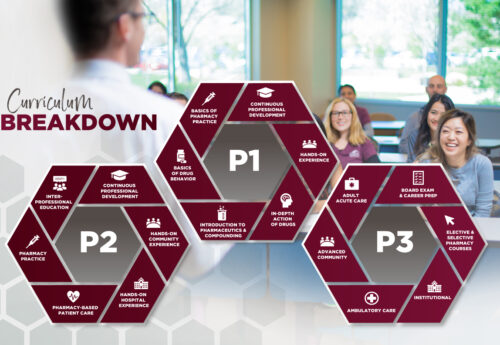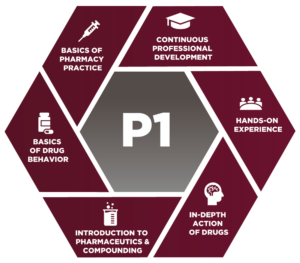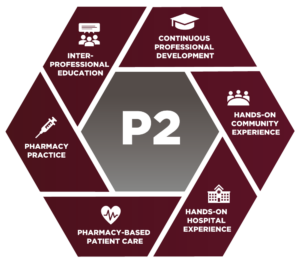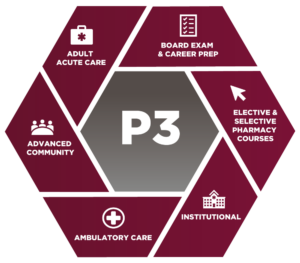Doctor of Pharmacy Curriculum

First Year Curriculum

The first professional year (P1) consists of 14 sequential blocks, 2 distributed blocks, Top 200 Drugs, and Introductory Pharmacy Practice Experiences.
A study of the composition and structure of proteins, classification of enzymes and coenzymes, enzyme kinetics and regulation, drug biotransformation, drug-receptor properties, structural features of drugs, functional group properties and receptor interactions, fundamentals of pattern recognition that relate chemical structure to pharmacological action, drug dose-response curves, membrane structure, and transport, and mechanisms of signal transduction.
A study of the basic concepts of mammalian biochemistry including the biosynthesis of proteins, nucleic acid structure, and function in gene expression at the cellular level in both normal and disease states. Additionally, there is a review of nucleotide metabolism, an introduction to the pharmacology of antineoplastic agents, and an introduction to pharmacogenomics.
A study of the basic concepts and principles of mammalian biochemistry including the digestion, absorption, biosynthesis, and metabolism of carbohydrates, lipids, and amino acids at the cellular level in both the normal and disease states. The principles of energy transformations are also studied.
A study of basic hematology and immunology and the fundamental principles related to clinical immunology.
A study of the practice of drug information, drug literature evaluation and searching, principles of evidence-based medicine, medical writing, medication safety, and pharmacovigilance.
This block introduces basic concepts of pharmacology and medicinal chemistry, particularly as applied to the autonomic and central nervous system. In this block, a study of the basic principles of drug action is presented for specific drug classes including the chemical properties, mechanisms of drug action, routes of administration, clinical uses, disposition, contraindications, adverse reactions, clinically significant drug interactions, and drug-disease interaction.
This block introduces basic concepts of pharmacology and medicinal chemistry, particularly as applied to the cardiovascular, renal, and pulmonary systems. In this block, a study of the basic principles of drug action is presented for specific drug classes including the chemical properties, mechanisms of drug action, routes of administration, clinical uses, disposition, contraindications, adverse reactions, clinically significant drug interactions, and drug-disease interaction.
This block introduces basic concepts of pharmacology and medicinal chemistry, particularly as applied to gastrointestinal, genitourinary, and skeletal muscle systems. In this block, a study of the basic principles of drug action is presented for specific drug classes including: the chemical properties, mechanisms of drug action, routes of administration, clinical uses, disposition, contraindications, adverse reactions, clinically significant drug interactions, and drug-disease interaction.
This block introduces basic concepts of pharmacology and medicinal chemistry as applied to the endocrine system. In this block, a study of the basic principles of drug action is presented for each specific drug class including: the chemical properties, mechanisms of drug action, routes of administration, clinical uses, disposition, contraindications, adverse reactions, clinically significant drug interactions, and drug-disease interaction.
An overview of fundamental principles of antimicrobial therapy and the basic pharmacology of antimicrobial agents along with a study of the basic principles of toxicology along with an introduction to clinical toxicology.
A study of the application of physical and chemical principles to the development, preparation, and stabilization of pharmaceutical dosage forms. Also included is a study of biological and physicochemical factors that influence the availability of a drug from a dosage form and the subsequent disposition and response of the drug in the body.
The application of the concepts of biopharmaceutics and kinetics to the rational design of individualized drug dosage regimens, taking into consideration such factors as hepatic and renal impairment.
A study of the history of pharmacy, the role of pharmacy in the US health care system, and the laws that have shaped contemporary pharmacy practice.
A study of the basic provisions of State and Federal pharmacy laws and regulations pertaining to pharmacy practice, licensure, controlled substances, poison, legal liabilities, laws and regulations of other health care providers, and pharmacy case law.
Students will complete didactic and skills-based learning on the topic of vaccine-preventable diseases, immunization policies and recommendations, running an immunization service, and practical skills for administering subcutaneous and intramuscular injections. Approximately 8 hours are spent completing a self-study that must be completed prior to the didactic and skills-based portion of the course, which requires an additional 8 – 10 hours.
This course (held throughout the P1 year) covers all aspects of pharmaceutical calculations including: fundamentals of measurement and calculation, measurement systems, dosage and concentration units, isotonic solutions, electrolyte solutions, and calculations related to compounding.
This course is offered throughout the first academic (P1) year and focuses on familiarizing students with the 200 most frequently prescribed drugs. For each drug, students will: identify the trade and generic names, identify the labeled indication; identify appropriate administration route, dose, and dosage forms of the drug for adult and pediatric patients; and identify the mechanism of action.
This course serves as an introductory therapeutics course focused on OTC self-care, complementary and alternative medicines, and nonpharmacologic interventions for medical conditions that are appropriate for pharmacist guided patient self-care.
This skills-based course is offered throughout the first academic (P1) year and strengthens the students’ communication, drug information, and patient care skills.
When: Longitudinal rotation, during the first academic year.
Number of hours: 128
Outcomes: The prescribed outcomes begin with becoming familiar with the practice site, the role and responsibilities of pharmacists and other site personnel, and culminate with the student performing rudimentary aspects of pharmaceutical care. Each preceptor is supplied with a checklist of abilities that the student is expected to demonstrate by the end of the experience. A copy of the checklist is submitted for review by the College at the middle and end of each rotation. Additionally, students complete IPPE related assignments and participate in Professionalism Day and IPPE Seminars.
This block is offered throughout the first academic (P1) year and is designed to mentor students through the beginning of their professional development. Students are assigned a faculty mentor who will be their point of contact throughout this course. Throughout the course, the student will build a portfolio that will document their professional development.
Second Year Curriculum

The second professional year (P2) consists of 15 sequential blocks, 1 distributed block, Top 200 Drugs, Scientific Writing, and Introductory Pharmacy Practice Experiences.
An integrated study of anatomy, patho-physiology, physical and laboratory assessment, pharmacology, therapeutics, clinical pharmaco-kinetics, patient care, alternative/complementary therapies, pharmacoeconomic issues, medication use in special populations, and review of pertinent drug literature as they relate to fluid homeostasis, electrolyte/mineral balance and major renal diseases.
An integrated study of anatomy, pathophysiology, physical assessment, pharmacology, therapeutics, clinical pharmacokinetics, patient care, alternative/complementary therapies, pharmacoeconomic issues, medication use in special populations, and review of pertinent drug literature as they relate to major cardiovascular diseases.
An integrated study of anatomy, pathophysiology, physical assessment, pharma-cology, therapeutics, clinical pharmacokinetics, patient care, alternative/complementary therapies, pharmacoeconomic issues, medication use in special populations, and review of pertinent drug literature as they relate to major immune disorders and diseases involving the eye. Also included are concepts pertaining to immunization.
An integrated study of anatomy, patho-physiology, physical assessment, pharma-cology, therapeutics, clinical pharmacokinetics, patient care, alternative/complementary therapies, pharmacoeconomic issues, medication use in special populations, and review of pertinent drug literature as they relate to major lung diseases.
An integrated study of anatomy, patho-physiology, physical assessment, pharmacology, therapeutics, clinical pharmaco-kinetics, patient care, alternative/complementary therapies, pharmacoeconomic issues, medication use in special populations, and review of pertinent drug literature as they relate to major gastrointestinal disorders.
A study of the basic principles of antibiotic action including, for each specific antibiotic class, the mechanism of action, routes of administration, disposition, contraindications, adverse reactions, and clinically relevant drug interactions. Also included is an integrated study of anatomy, pathophysiology, physical assessment, pharmacology, therapeutics, clinical pharmacokinetics, patient care, alternative/complementary therapies, pharmacoeconomic issues, medication use in special populations, and review of pertinent drug literature as they relate to major infectious diseases.
A study of the pharmacological principles of chemotherapeutic agents. Also included is an integrated study of anatomy, pathophysiology, physical assessment, pharmacology, therapeutics, clinical pharmacokinetics, patient care, alternative/complementary therapies, pharmacoeconomic issues, medication use in special populations, and review of pertinent drug literature as they relate to the major neoplastic and hematological diseases.
An integrated study of anatomy, pathophysiology, physical assessment, pharmacology, therapeutics, clinical pharmacokinetics, patient care, alternative/complementary therapies, pharmacoeconomic issues, medication use in special populations, and review of pertinent drug literature as they relate to endocrinology and endocrine disorders.
An integrated study of anatomy, pathophysiology, physical assessment, pharmacology, therapeutics, clinical pharmacokinetics, patient care, alternative/complementary therapies, pharmacoeconomic issues, medication use in special populations, and review of pertinent drug literature as they relate to major psychiatric disorders.
An integrated study of anatomy, pathophysiology, physical assessment, pharmacology, therapeutics, clinical pharmacokinetics, patient care, alternative/complementary therapies, pharmacoeconomic issues, medication use in special populations, and review of pertinent drug literature as they relate to major neurological disorders.
A study of the pathophysiology, administration, pharmacology, patient care, alternative/complementary therapies, pharmacoeconomic issues, use in special populations, and review of pertinent literature as they relate to the practical applications of nutrition therapy. In addition, optimal nutrition for healthy adults and children will be reviewed.
An integrated study of anatomy, physiology, pathophysiology, physical assessment, pharmacology, therapeutics, clinical pharmacokinetics, patient care, alternative/complementary therapies, pharmacoeconomic issues, medication use in special populations, and review of pertinent drug literature as they relate to contraception, gender-specific disease states and/or conditions.
An integrated study of anatomy, pathophysiology, physical assessment, pharmacology, therapeutics, pharmacokinetics, patient care, pharmacoeconomic issues, medication use in special populations, and review of pertinent drug literature as they relate to major diseases that are often associated with critical care medicine. Assimilated into this course will be components of pulmonology, cardiology, and other disciplines of medicine commonly seen in the intensive care setting.
A study of the practice of drug information, drug literature evaluation and searching, principles of evidence-based medicine, medical writing, medication safety, and pharmacovigilance.
A study of the economic, social, and political forces affecting the delivery of health care services. In addition, the effect of these forces on pharmacy practice and the impact of pharmacy on the health care system are explored. Also included are concepts related to people management skills.
This course is offered throughout the second academic (P2) year and focuses on familiarizing students with the 200 most frequently prescribed drugs. This course builds on the objectives of PHAR 451 and assesses students’ ability to identify the mechanism of action, therapeutic dose, contraindications, black box warning, adverse effects, and controlled schedule for each drug.
This skills-based course is offered throughout the second academic (P2) year. This course builds upon the skills developed in PHAR 465 and further strengthens the students’ communication, drug information, and patient care skills.
This skills-based course is offered throughout the second academic (P2) year and places students in small groups with direct faculty guidance. This seeks to prepare students to break down patient cases, practice presenting skills, and further integrate material covered throughout a student’s time at Roseman.
When: Longitudinal rotation, during the second academic year.
Number of hours: 144
Outcomes: The learning outcomes build upon those assessed in PHAR 470 and PHAR 472. Each preceptor is supplied with a checklist of abilities that the student is expected to demonstrate by the end of the experience. A copy of the checklist is submitted for review by the College after the middle and at the end of each rotation. Additionally, students complete IPPE related assignments and participate in Professionalism Day and IPPE Seminars.
When: During the summer between the first and second academic year.
Number of Hours: 160 (4 weeks at 40 hours per week minimum)
Outcomes: The outcome expectations for the IPPE Community 4 Week Block experience build on those from IPPE, culminating with the student being able to perform all duties expected of an entry-level pharmacist. Each preceptor is supplied with a checklist of abilities that the student is expected to demonstrate by the end of the experience A copy of the checklist is submitted for review by the College after the middle and at the end of each rotation.
When: During the summer between the first and second academic year.
Number of Hours: 80 (2 weeks at 40 hours per week minimum)
Outcomes: The outcome expectations for the IPPE Institutional 2 Week Block experience begin with students being introduced to the distributive and logistical functions of inpatient pharmacy services at a hospital. Additionally, students are exposed to clinical and patient care activities in the institutional setting. Each preceptor is supplied with a checklist of abilities that the student is expected to demonstrate by the end of the experience. A copy of the checklist is submitted for review by the College at the end of each rotation.
This block is offered throughout the second academic (P2) year and is designed to mentor students through the continuation of their professional development. Students are assigned a faculty mentor who will be their point of contact throughout this course. Throughout the course, the student will continue to build a portfolio that will document their professional development.
In this course, students work within interprofessional teams comprised of a variety of practice settings including Osteopathic Medicine, Nursing, Physician Assistant, Physical Therapist, Respiratory Therapist, and more. Together students will learn about the Interprofessional Education Collaborative’s (IPEC) Core Competencies and how to apply those concepts to work as efficient and effective members of the healthcare team in order to provide patient-centered care.
Third Year Curriculum

The third professional year (P3) consists of Advanced Pharmacy Practice Experiences, Electives, and a Longitudinal Capstone course.
When: Third academic year
Number of Hours: 1,440 (Six-week rotations; minimum of 40 hrs/week)
Outcomes: In general, the outcome expectations for APPE represent further advancement of student abilities to include the provision of pharmaceutical care and disease state management. Each preceptor is supplied with learning outcomes that the student is expected to demonstrate by the end of the six-week experience. An assessment form of the learning outcomes is submitted for review by the College after the third week and at the end of the rotation.
Each student must complete PHAR 601, PHAR 602, PHAR 603, PHAR 604.
Selective experiences include all specialty pharmacy practice experiences. The areas of specialty for these experiences include but are not limited to: drug information, cardiology, critical care, pediatrics, geriatrics, infectious disease, hematology/oncology, surgery, nutrition, and pain management. The number of the different selective experiences may vary annually based on site and preceptor availability.
Each student must complete at least two Selective APPE Rotations.
The overall goals of the Adult Acute Care experience are to promote student knowledge, skills and abilities and to effectively participate in the patient care, decision-making process in the inpatient institutional setting. During these experiences the student will have the opportunity to participate in ongoing clinical activities. The student will function as an integral part of the health care team and will gain experience with patient interviewing techniques, patient monitoring, clinical use of drugs, chemical concentrations in biological fluids, and manual and computerized methods for planning dosing regimens. Emphasis will be placed on student’s demonstration and understanding of common disease states and treatment modalities.
The overall goals of the Advanced Community experience are to promote student knowledge, skills and abilities and effectively participate in the patient care, decision-making process in the community pharmacy setting. Emphasis will be placed on disease state management, the development of professional attitudes and judgment.
The purpose of this rotation is for students to gain professional skills in an ambulatory care practice environment. The Ambulatory Care rotation affords students the opportunity to effectively participate in the patient care decision-making process. Students will participate in a variety of clinical activities, functioning as an integral member of the healthcare team. Emphasis will be placed on the student’s ability to demonstrate their understanding of common disease states and treatment modalities as well as their ability to provide pharmaceutical care.
The purpose of this rotation is for students to gain professional skills in the distributive functions of pharmaceutical care in the inpatient setting (e.g., prescription orders and order entry, dispensing, record keeping, patient interviewing and counseling, patient profiles/charts, third-party billing, legal requirements, compounding, sterile products, communication with other health care professionals, inventory control and etc.)
This course is offered throughout the third (P3) and final academic year and after the students have completed the experiential curriculum. The course utilizes RxPrep and offers a series of assessments and in-class reviews prepare the student for licensure examination and entrance into the profession. Time is also set aside in this course to prepare students for job interviews and CV and resume preparation.
Elective courses are typically taken in the P3 year. It is possible to take electives prior to the P3 year with approval of the instructor and the Assistant Dean for Academic Affairs. Students must have at least P2 status in order to enroll in any elective courses.
Each student must complete 4 credit hours of elective courses with may include additional pharmacy practice experiences.
Available elective courses may be found in the Student Catalog.

Six-Point Mastery Learning Model®
Roseman University strives to produce competent graduates in an educational environment that ensures high levels of achievement from all students and fosters cooperation and collaboration in the learning process. This is the concept of mastery learning.

Classroom As Teacher

Block Curriculum

Active & Collaborative Learning

Competency-Based Education

Assessment Learning

Early Experiential Learning